Update #16 - December 2001
Cartagena
Colombia
Distance run to date : 12,648 nm
(14,555 statute miles ; 23,424 km)
Our first stop, a 100 miles out of Trinidad was Los Testigos, a small group of Venezuelan islands that support about 200 fishermen and their families. It was a great feeling to be away from the rain and oppressive humidity of Trini, with the bonus that we were able to jump off the boat into clear water. In addition to lots of swimming, we climbed the local hill (850ft) for fantastic views over the archipelago. Later we surfed down a huge dune that the strong trade winds had formed, by blowing sand from a beach up between two hills.
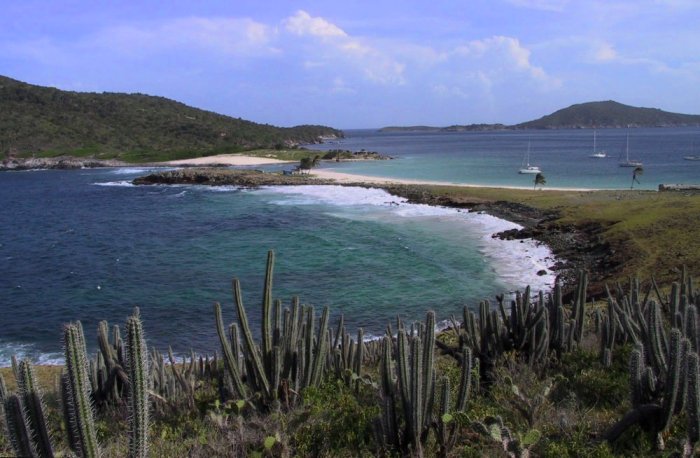
Puerta Real, the most westerly of our three Testigo anchorages
The next stretch retraced some of the ground we had covered on our Venezuelan trip last year but it proved to be just as rewarding. We replenished our supplies (yet again) in Porlamar, on the duty free island of Margarita, in particular some excellent Chilean Caberney Sauvignon @ £1.30 and gin/rum @ £1.50 a bottle. What is the real price of 'duty free' thought Amoenitas as her waterline plumbed new depths?
After a brief stop at Tortuga we were back at Los Roques, certainly one of the magic places that will always be amongst the top spots of our world cruise. The superb colours of the sea around the reefs are surreal and the diving is the best Dave has experienced anywhere. Reef fish of almost every specie are in profusion, with never less than 200 or so in view at any time, not to mention the exceptional sponges and corals. Dave took masses of underwater pictures which we still need to get down to scanning.

A Red Footed Booby and parent by the nest in the mangroves on Ave de Barlovento
Our first new destination was Las Aves (birds), an appropriate name as the easternmost of the two island groups is home to a large colony of Boobies and Frigate birds. The fishing was also good, Dave speared a large Mutton Snapper which provided the best fish eating we have ever enjoyed. The diving there was good too, with the compressor a permanent fixture on the aft deck for almost a month from Los Roques to Bonaire.
The next island group was the ABCs or BCAs as we took them. Bonaire and Curacao are still part of the Netherlands Antilles but Aruba has gained a greater level of independence. Bonaire is quiet and typically Dutch being neat and tidy with an economy based almost entirely on diving tourism. There are around a hundred marked sites of which Dave managed about six. The drop-off is very sudden and the scenery fantastic but the fish life cannot compare with Los Roques or Las Aves. Curacao in contrast has a thriving economy, much of it based on refining oil from the nearby Venezuelan field at Lake Maracaibo. We enjoyed the nearly three weeks we spent on these friendly islands.

The typically Dutch seafront properties in the port of Willemstad, Curacao
Aruba has no good anchorages, so we hung off a beach with around 6" under the keel for one night before heading out to 'The Rock'. Monjes el Sur is a Venezuelan Coastguard outpost 20 miles off the Colombian coast, right in the thick of the drug trafficking area. The island had been a base for Colombian pirates who preyed on passing small craft until 1952 when Venezuela gained international permission to regain control. It is now home to 20 Guarda Costa whose Commander, Jose is the most friendly official we have ever encountered. The picture shows the three boats in our fleet tied to a line stretched across the man made harbour formed by infilling the gap between two islands. Being in company with other boats is essential along this coastline where kidnapping, drug smuggling and piracy are endemic.

View down onto the harbour from the top of Monjes el Sur, "The Rock"
Our next long leg along the Colombian coast gave us an introduction to the strong winds, rough seas and thunder storms that this neck of the Caribbean is renowned for. So, it was with some relief that we pulled into the shelter of the Five Bays, nestling beneath the Sierra de Nevada de Santa Marta, at around 19,000ft which is the worlds highest coastal mountain range. The beautiful Guayraca Bay was like a fiord with strong gusting williwaws off the steep hillsides. There were few dwellings, mostly thatched roofed and almost all the small fishing craft were dugout canoes propelled by paddles.
This area was the home of the Tairona Indians and with the help of Renaldo, who was most probably a part time grave robber, we toured the old tribal burial sites. These comprised tens of acres of closely spaced, 2m deep holes between almost every tree in the forest, giving an impression of the Somme battlefield after a major attack. The prize was the gold jewelry and ornaments that so many of them had been interned with. Later in the Gold Museum in Cartagena we were able to appreciate not only the amazing craftsmanship of their creators but also social and political infrastructure that had made such art possible.
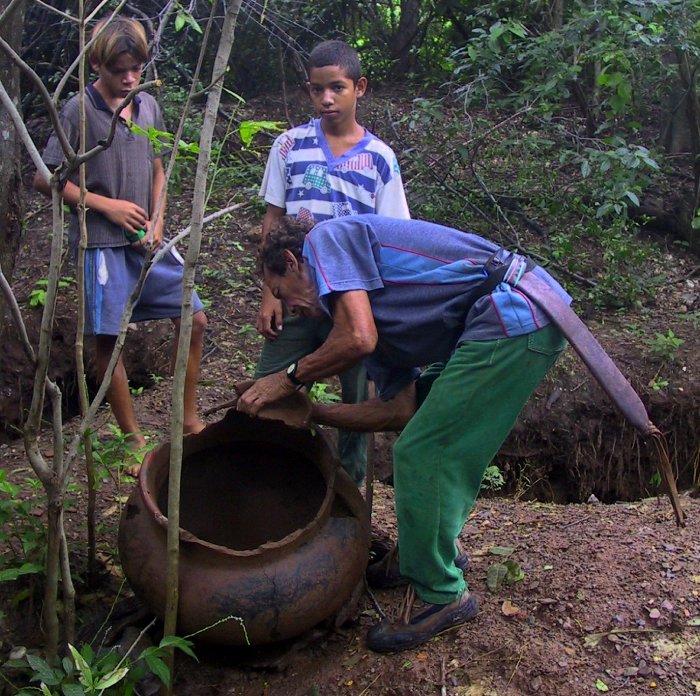
Renaldo Garcia with his two sons showing us a Tairona Indian burial urn
Here we are at a second bay, Ancon Concha where we walked ashore and watched the fisherman setting their seine nets from paddled canoes. We crossed the small stream in the background and were surprised by the ice cold temperature of the water before realising it had probably been meltwater from the snows of the Sierra Nevada.

A rare picture of the two of us in Ancon Concha (Dave is usually behind the lens)
Having sailed 977nm along the South American coast, we arrived at Cartagena late on the afternoon of Sun 25th Nov to a Wagnerian welcome of driving rain, thunder and lightning. It was good to arrive as this is a magnificent city, so little visited due to the troubles in Colombia but one where we were looking forward to spending some weeks. It has lived up to its promise in every way. The Club Nautico offers us all a warm welcome and every service we could need but especially cheap cold beers and lots of space to chill out with all the other cruisers from around the world heading west.
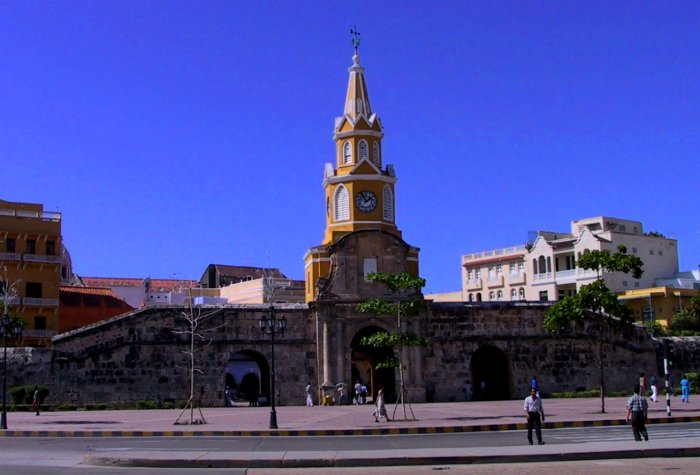
Puerta del Reloj, the 18th century, north western entrance to the old town of Cartagena
The old walled town is about 20 minutes walk from the anchorage and a delight to explore. Churches and museums abound amidst the thousands of three or four century old Spanish Colonial houses. One can spend weeks there continually discovering new treasures. Another feature is the profusion of excellent restaurants, all of which offer remarkable value.

Like most of the old town of Cartagena, the gate is beautifully illuminated by night
The wealth on which the city was based came from the plundering of the northern South American states by the Spanish. It became the major collection point for the gold and treasures taken from the Indians before shipping it back to Europe. The fort of San Filipe dominates the town from an inland hill and is riddled with underground passages with chambers on either side to store the bounty. It was this inland site that prevented the British, led by Admiral Edward Vernon from capturing the city in 1741. Though they overran the defensive coastal forts and captured most of the surrounding ground, this fort on high ground was immune to attack by the 2.070 British cannons which could not cope with the elevation required.

Fort San Felipe, constructed in 15/16th century to house gold prior to shipment to Spain
There are so many large churches that we really needed to ration ourselves to visiting no more than a couple a day. One of our favourites, San Pedro, which had a monastery attached that was dedicated to St Claver who gave his life to the welfare of slaves. Like most of the major buildings of the old town it is beautifully lit at night. The evening temperatures are perfect, so strolling the town before and after dinner is a pleasure, marred only by the numerous hawkers and beggars. Excepting the occasions that cruise ships visit, there are really not many tourists around so after a week or so we got to know most of the hawkers and could share a joke or chat with them without hassle.
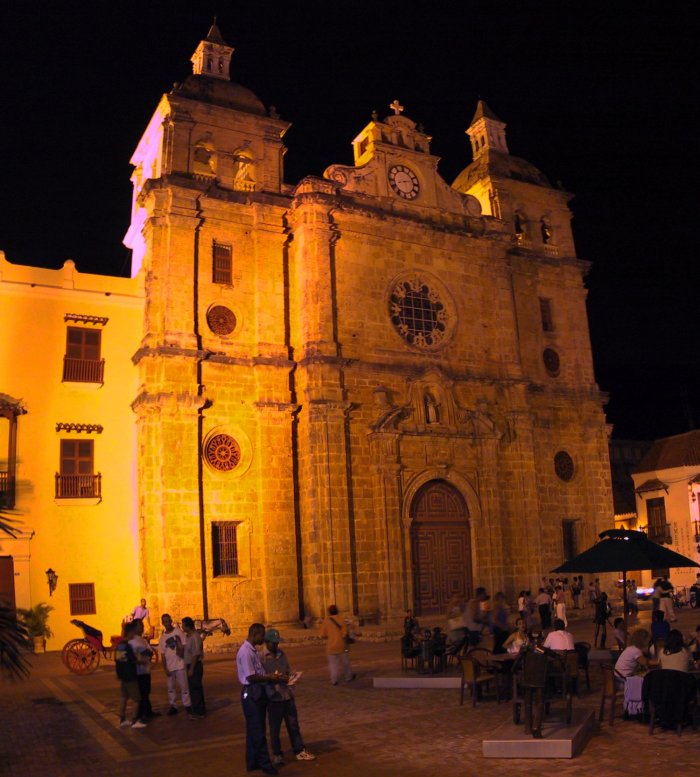
San Pedro Claver, a 17th century Jesuit church and monastery
In the Plaza de San Pedro above you may be able to pick out the sculptures set on small plinths. There were around ten of these exquisitely expressive groups representing figures at work and play. Here is the street cleaner.

One of the ingenious sculptures in the Plaza de San Pedro Claver
Wherever one is in the town it difficult to escape from a view of the cathedral tower. The interior of the building is somewhat plain but is contrasted by the ornate tower. This street is typical with a mixture of untouched and renovated properties almost all with large balconies supported by substantial wooden beams.
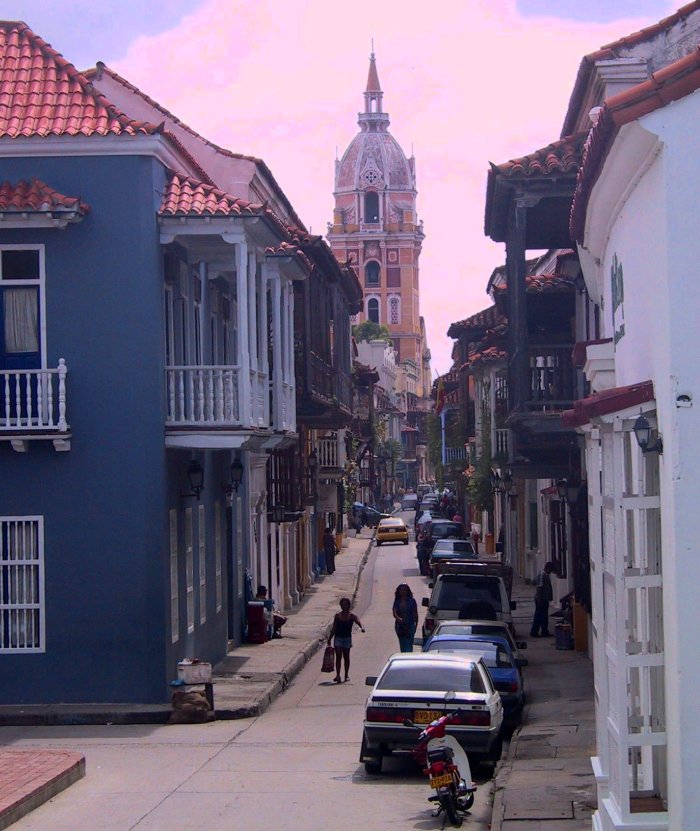
The cathedral spire dominates the streets of the old town
Another recurring architectural theme is the cool, shady courtyard. We must have poked our heads into hundreds of superb examples. So often when we showed interest, we were invited in by the guard (yes this is still Colombia so there is always a guard). Excuse the distortion in the picture which due to the enclosed space, was created from four exposures joined together electronically. There are other 'stitches' on this page such as the waterfront at Willemstad, San Filipe Fort and San Pedro which are less obvious.
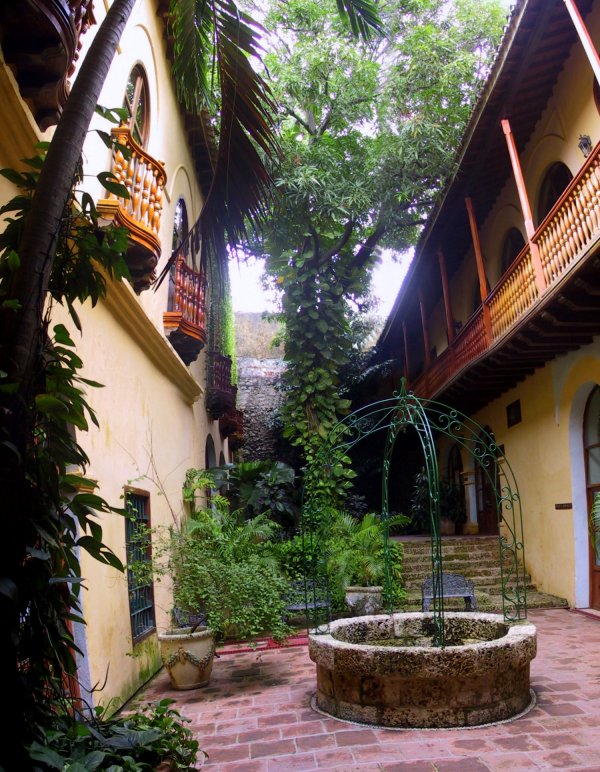
One of the many hundreds of courtyards we peered into
Museums abound on almost all subjects relevant to the city. The one we probably enjoyed most was the Gold Museum, not so much for the excellent displays of that art but also for the appreciation we gained of the city's architecture and the pre-Colombian social and political structures. The Museum of the Inquisition was vividly gruesome with all the paraphernalia of torture surrounded by explicit contemporary pictures set out like an operating manual. Below is the square housing another great collection in the Naval Museum. This had great detail on the coastal fortifications including the submerged wall we had negotiated as a short cut into the harbour. Had we known then how well it had been constructed, our crossing through a narrow gap with around 1m under keel would have been even more scary!

Looking from the Baluarte de San Francisco toward the Naval Museum
We can't recount our impressions of Cartagena without including an image of one of the thousands of buses that clog the plazas and weave unpredictably around the arterial roads like dodgems. It is difficult to find any two that look at all similar in decoration and all of them try to discover how much the drivers view of the road can be obscured before making it inoperable.

No two buses look alike and all had major obscuration of the driver's vision
Well, that's our story from Cartagena and instead of our usual concluding sunset we have a festive theme this time, with a view of the decorations of a ground floor apartment around a 100m from the Club Nautico.

Replacing our usual sunset is a Cartagena festive display (note the heavy duty posts and railings)
Where to next:-
After two years in the Caribbean we are about to switch oceans and begin a long trek across the Pacific. Our next move is to the charming, remote San Blas Islands off Panama where we plan to spend Christmas roasting pig and lobster on the beach with the Kuna Indians. This puts in a good position to transit the Panama Canal in February 2002.
Once in the Pacific we plan to head south along the coast of Ecuador probably stopping off to do some inland travel before a 700nm sail to the Galapagos Islands which straddle the Equator. Then a 3000nm passage into the South Pacific, heading for the Marquesas in French Polynesia. Then onward to a mass of magical island names, like Tahiti, Bora Bora, the Cook Islands, then to Fiji or Tonga where in about October we will make the difficult 1000nm passage to New Zealand.